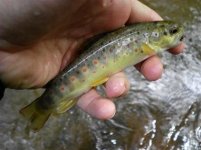pcray1231 wrote:
Yeah, brookies handle acidic waters the best. What I'm not sure of, is whether its the fish that handle them better, or the eggs. My impression is the latter because travelling browns seem to do just fine, but they can't establish strong populations.
This strength of brookies is one of the only things that has kept them around, IMO. Browns are dominant. Everywhere that browns can establish in numbers, it seems that in time, they take over the brookies. Remember, brookies weren't always the fish of the headwaters, they were everywhere. Headwaters, big rivers, limestoners, etc. It's just that they've been driven out of most of their former haunts by habitat degradation and brown trout. Headwaters are merely the last fortress. Browns invade, but can't gain a foothold.
That said, you then find some brookies in limestoners coexisting with browns. BFC, Big Spring, and others. I haven't yet figured out how they manage, when they didn't manage in so many seemingly similar streams??? Is there separate breeding areas, like tribs or something, that continually supply a source of adult brookies to the big water?





